CBSE has paired Bihar with Tripura and Mizoram. This has been done under the Centre’s ambitious scheme ‘Ek Bharat Shreshtha Bharat’ Abhiyan. Now The students of all the three states have to involve in various activities for understanding the History, art and culture, education, literature and traditions of each other.
Under Ek Bharat, Shreshtha Bharat Abhiyan, the students will now have to organize exchange programmes and cultural events in their respective state. Through such activities, the students of Tripura and Mizoram will have a better understanding about art and culture and History of Bihar. At the same time the students of Bihar will also know and learn about the art, culture and history of Tripura and Mizoram.
Bihar, Tripura and Mizoram Under Ek Bharat Shreshtha Bharat
Introduction of Bihar, Tripura and Mizoram
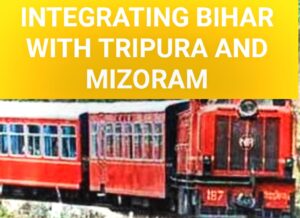
CBSE ART INTEGRATION PROJECT UNDER EK BHARAT SHRESHTHA BHARAT-2021-22
Bihar
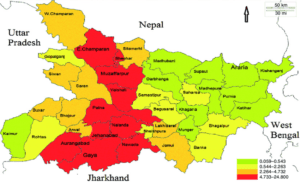
Pol. Map of Bihar
Bihar lies in Eastern part of India.
It has an international border with Nepal.
West Bengal lies to its North East and Uttar Pradesh to it’s West.
Jharkhand lies to its south (from November 2000) after getting separated from Bihar.
Bihar is the third largest state in terms of population.
The capital of Bihar is Patna.
Tripura

Pol. Map of Tripura,
Tripura lies in the North-Eastern part of India.
It shares an International border with Bangladesh.
It is bounded by the Indian states of Assam to the North -East and Mizoram from East.
Tripura is the third smallest state in terms of size after Goa and Sikkim.
Agartala is the capital of Tripura.
Mizoram
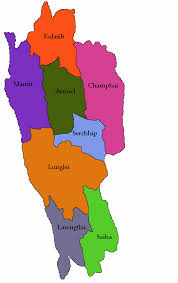
Pol. Map Of Mizoram
Mizoram is one of the most beautiful states located in the North-East of India.
It is a small state named after Mizo tribe.
Earlier this state was known as Lushai Hills and was the part of Assam.
In February 1997, it became an independent state.
It shares it borders with Tripura from the west, Assam from the North and Manipur from the east.
Also shares International border with Bangladesh and Myanmar.
Aizawl is the capital of Mizoram.
Project On Integrating Bihar With Tripura and Mizoram
http://https://www.youtube.com/watch?v=9VTAQ8gdB0s
History of Bihar
Bihar, the word originates from the “viharas” which means rest house of Buddhist monks.
Muslim rulers of 12th century named it Bihar.
It is the birth place of Buddhism – where Gautam Buddha got enlightened.
In Bihar, Jainism also came into existence with the advent of Vardhman Mahavira.
Bihar has mainly three distinct regions, Magadh, Mithila and Bhojpur (Anga).
Magadha (Patna), Mithila (Sitamarhi) and Anga (Bhagalpur) are also mentioned in religious texts and epics of ancient India.
Mithila became powerful after the establishment of the Videha kingdom.
The Kings of the Videha Kingdom were called Janakas.
Sita is considered to be the daughter of king Janak as is mentioned in the Hindu epic Ramayana.
During the Mauryan period, Bihar witnessed the development in every field like Social, Political, Religious, Cultural and Economic.
Patliputra was the capital of Mauryan empire.
It was ruled by great rulers like Chandragupta Maurya, Bindusara and Ashoka.
Bihar played a very small role in Indian history until the emergence of Suri dynasty during 1540s.
Sher Shah Suri defeated Humayun and captured Bihar.
After the fall of Suri dynasty, Bihar started loosing its importance.
It became prominent once again when Champaran movement was started by Mahatma Gandhi.
Bihar was made a separate province during the British Indian Empire.
Bihar is an independent state of Indian union since 1947.
History of Tripura
Modern Tripura was ruled for several centuries by the Tripuri dynasty.
It was a princely state during British rule.
Tripura is mentioned in Mahabharata, Puranas, old religious texts and stone pillar inscriptions of the emperor Ashoka from the third century BCE.
The Geographical boundary of Tripura changed over the centuries.
It’s borders reached up to Sunderbans in Bengal, Up to Burma in the East and Assam in the North.
There were several Muslim invasions during the 13th century.
The Mughals had influence over the appointment of the Tripuri kings.
History of Mizoram
Mizoram, one of the seven sister states lies in North-Eastern part of India.
It is one of the most beautiful states of India with many hills.
Earlier this state was known as Lushai Hills.
Moreover, there is very less information available about the history of Mizoram.
It is believed that the Mizo tribes entered from China in the 16th century.
From then onwards the history of Mizoram is known to us.
There were several tribal wars between 18th and 19th century.
In 1898, Mizoram came under the control of British.
After that, In 1946, a political party named “Mizo common people’s union” was formed.
People of Mizoram demanded separate state.
In 1987 Mizoram became an independent state of Indian union.
Popular Art of Bihar, Tripura and Mizoram under ek Bharat – Shreshtha Bharat
Art and craft of Bihar
Bihar is known for it’s Madhubani art paintings.
Today also this art form is live in some parts of Bihar.
This painting is local art of Madhubani district, hence its name read Madhubani painting.
This art portrays nature and mythology depicting various events such as marriage and the cycle
of birth. Originally, lotus flower, bamboo,
bird, snake etc. artifacts are also found in these paintings.
These images are depicted as representing reproduction and spread of birth.
Madhubani paintings are generally based on Lord Krishna, Ramayana scenes such as images of God and religious themes.
Madhubani paintings are painted with natural colors, in which cow dung and mud are used to improve these paintings in the walls.
Artists used only natural colors in their art, including turmeric, pollen, or chose blue and blue with indigo.
The juice of safflower flower was used for red color, sandalwood or rose.
Art and craft of Tripura
Tripura’s Tribal handloom art from cane and bamboo
Tripura people are skilled in making use of cane and bamboo.
Cane and Bamboo craft are the main crafts of Tripura.
Tribal groups in Tripura make wide variety of handicraft products using bamboo and cane.
These handloom art of Tripura reflect the inborn art of workmanship, and uniqueness of the people.
Handloom is the prime craft of Tripura.
Tribal customs, folksongs and folklore are important elements of the culture of Tripura.
Tripura has a wonderful tradition of arts and crafts, textiles, wood carving, basket making and cane and bamboo works.
This handicraft is spread across the state.
There is a flourishing industry of bamboo mats in Tripura. .
Some mat sets have decorative oil paintings made by local artists.
Art and craft of Mizoram
The art and craft of Mizoram is very similar to Tripura.
Mizoram is known for its bamboo, textiles, cane works and basketry.
Women of Mizoram state are associated with weaving.
The bamboo and cane craft is one of the main traditional crafts in Mizoram.
People make variety of items from bamboo and cane. From furniture to many commercial items for the tourists.
People make beautiful hats baskets of various shapes and sizes.
Among the many purposes that baskets in Mizoram serve, one of them is storing clothes, ornaments and other valuable items.
While broad baskets are meant for cotton, vegetables and firewood, closed baskets are used for grains.
Along with the use of cane and bamboo, fibers and leaves are also used.
Famous Festivals of Bihar, Tripura and Mizoram under ek Bharat – Shreshtha Bharat
India is a land of multi culture, multi festivals, multiplr beliefs and multiple religions.
Visit any part of the country, you will come across some unique culture.
Festivals in India gives an opportunity to get together with friends and family.
Each state has a festival which is unique and is different from the rest.
Bihar celebrates many festivals like Durga Puja, Bhaiya dooj, Holi, Diwali etc.
But Chhath Puja is one festival that is uniquely associated with Bihar.
Chhath Puja – The most popular festival of Bihar
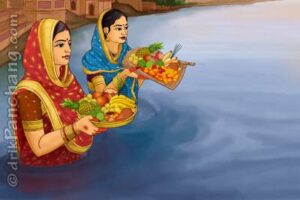
CHHATH PUJA – IMPORTANT FESTIVAL OF BIHAR, Ek Bharat Shreshtha Bharat
Chhath puja is one of the most famous festivals of Bihar.
People worship Sun God (the only visible God on earth) during Chhath Puja.
It is celebrated six days after Diwali.
It is an expression of thanks giving and seeking blessings from the Almighty for sustaining life on Earth.
During this festival, the person observing Chatth, has to keep fast from dawn to dusk which ends or breaks with sweet dish (Kheer).
On the second day of Chhath festival, person observing Chhath worships the setting Sun.
Chhath Puja ends on the third day after worshipping the rising Sun.
This festival is considered to be the most sacred and difficult due to three days of fast.
Buddha Jayanti:
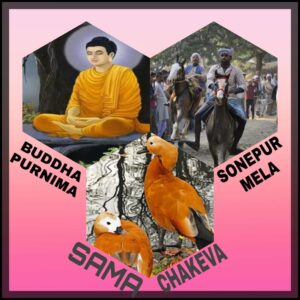
Other Important Festivals Of Bihar, Under Ek Bharat Shreshtha Bharat
Bihar is the birth place of Gautam Buddha where he attained enlightenment.
Buddha Jayanti is, therefore, an important festival in Bihar.
It is celebrated in Bodh Gaya and Rajgir on a full moon day in May.
The celebrations begin from 80-ft tall Buddha statue up to the Bodhi tree behind the temple.
The procession is attended by the disciples of Buddha and by many international tourists.
Sonepur Cattle Fair
Sonepur is situated at a place where river Ganga and Gandak meet.
The cattle fair at Sonepur is Asia’s largest fair.
It is believed that Chandragupta Maurya used to buy elephants and horses from here.
During the fair, handicrafts and handlooms are also displayed along with traditional dances and
magic shows.
Sama-Chakva
Sama-Chakeva, a ten day festival has a special significance in Mithila.
It is a festival that relates strong bond between brothers and sisters.
The festival begins soon after the arrival of colourful migratory birds.
These birds are locally named as Sama and Chakva.
Sama is believed to be daughter of Lord Krishna.
She was falsely accused and was turned into a bird.
Chakva, her brother helped her to get back to human form.
Popular festivals of Tripura
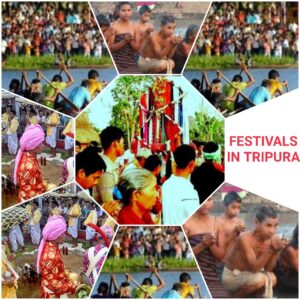
Festivals of Tripura – Ek Bharat Shreshtha Bharat
Tripura is known for its rich culture, traditional festivals and the 185 kings from the Manikya dynasty.
The state witness and celebrate many age-old festivals.
Some of the popular festivals celebrated are Garia puja, Kharchi Mela, Neermahal water festival,
Poush Sankranti or Tirthamukh mela etc.
Garia Puja:
Garia Puja is one of the most celebrated festivals by the people of Tripura.
A bamboo symbolizes Lord Garia, which is the symbol of livestock and wealth.
With flowers and garland along with cotton, rice beer, wine, earthen pots, eggs
and other traditional materials, Lord Garia is worshipped.
It is celebrated on the seventh day of Baisakh (April month).
Kharchi Puja:
Kharchi Puja is a festival where 14 Gods and Goddesses are worshipped in the Chaturdash Devata temple.
This festival is believed to be started by the kings.
It falls in July on eighth day of new moon.
Hundreds of devotees mark their presence at the temple to offer prayers.
Neermahal water festival:
Neermahal or the ‘lake palace’ of eastern India, was built by Maharaja Bir Bikram Kishore Manikya Bahadur in 1939.
This lake is spread over 2100 acres of water.
Local people and the state government jointly organise this water festival for three days.
Many cultural programs and boat race between many groups is the major attraction in the Rudrasagar lake.
Poush Sankranti or Tirthamukh mela:
Poush Sankranti is a festival which resembles Makar Sankranti.
People on this day take a holy dip in the river Gomati.
It marks the commencement of the Sun’s Uttarayan (Northern course in January).
It is believed to be one of the oldest festivals of Tripura.
Conclusion: Bihar, Tripura and Mizoram Under Ek Bharat Shreshtha Bharat
By integrating Bihar with Tripura and Mizoram, believe me you will increase your knowledge by many folds. I myself belong to Bihar but I was not aware of the festival called Sama Chakva. Similarly while writing this article, I could know many facts and festivals of North -East India. Tripura and Mizoram are full of hillls, no fertile soil, no resources, no industries, no railways but still people have learnt to live happily. This is what is the purpose of ek Bharat Shreshtha Bharat.
If you have got any project on integrating Chhattisgarh with Gujarat, you may click on the given link.



0 Comments